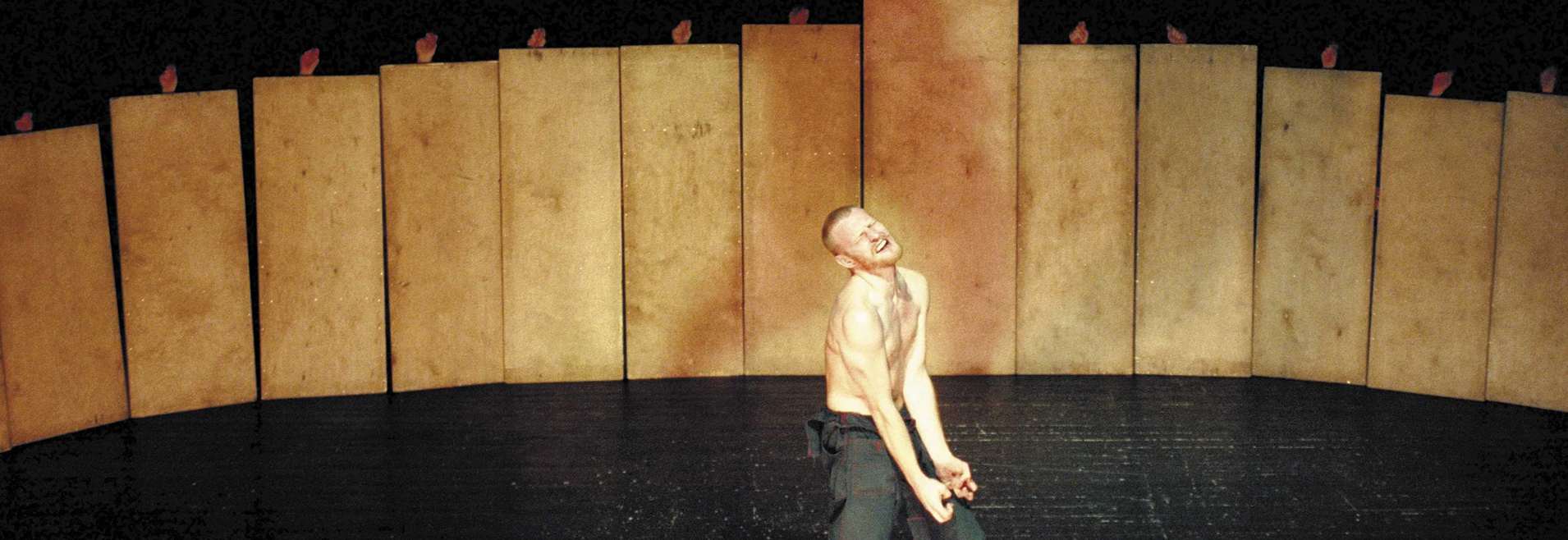The younger generation of directors that had debuted in the 1990s merged into the mainstream of Lithuanian theatre in a cultured manner, but also with its own brilliance and with immediate acclaim. This group – led by Cezaris Graužinis, Gintaras Varnas and Oskaras Koršunovas – did not foment rebellion and continued to develop the traditions of authorial direction established by their "fathers", while at the same pursuing forms of stagecraft to define their own freshness and originality.
The pursuits of other younger directors of the 1990s were not as noticeable. Rolandas Atkočiūnas debuted in 1991 with a production of Tennessee Williams' Kingdom of Earth (The Seven Descents of Myrtle) at the Russian Drama Theatre of Lithuania, and later worked at the Kaunas Small Stage, and the Šiauliai and Kaunas Drama Theatres, usually staging modern plays by Arthur Miller, Samuel Beckett, August Strindberg, Kostas Ostrauskas, Luigi Pirandello, Jean-Paul Sartre, and others. Ignas Jonynas became a director at the Youth Theatre in 1994. His most significant productions of the 1990s were Edmond Rostand's Cyrano in 1996 and The Night Just Before the Forests by Bernard-Marie Koltès in 1998. Jokūbas Vilius Tūras began working at the Youth Theatre in 1994 and has directed, among other productions, Jean Cocteau's Orpheus (1994), and Aldo Nicolaj's Be a Man, Celestino! (1997). Gintaras Liutkevičius premiered in Carlo Goldoni's La locandiera (The Mistress of the Inn) at the Vaidila Theatre in 1996, and went on to direct, among other plays, Harold Pinter's The Caretaker in 1997 at the Academic Drama Theatre, and Road by Jim Cartwright in 1999 at the Youth Theatre.
Almost in unison, the younger directors of the 1990s began their creative careers by turning to the modernism of the early 20th century and bringing new relevance to aspects of the period that had been silenced in Lithuanian theatre history. In 1989, Graužinis mounted a production for the stage of Knut Hamsun's Hunger and, soon after, directed Leonid Andreyev's Waltz of the Dogs at the Šiauliai Drama Theatre in 1991. After his work at the satirical Šėpos Theatre, Gintaras Varnas discovered Federico García Lorca and directed his play Once Five Years Pass at the State Small Theatre in 1993, revealing with it new experiences in surrealism, aestheticism and modern baroque on stage.
In truth, Lorca was not unknown to Lithuanian theatre. His work was first shown in Lithuania with Henrikas Vencevičius' staging of The House of Bernarda Alba at the Kaunas Drama Theatre in 1964. Lorca's work was further explored by Gytis Padegimas in 1976 at the Šiauliai Drama Theatre, when he directed Doña Rosita the Spinster and the Language of Flowers, and again with his staging of Yerma at the Kaunas Drama Theatre in 1992. But it was nevertheless Gintaras Varnas who truly discovered Lorca – he recognized himself in the author, and found Lorca to be an "ally" of his theatrical vision. In 1997 he staged Lorca's The Public at the Academic Drama Theatre, Doña Rosita the Spinster and the Language of Flowers at the Kaunas Drama Theatre in 2003, and remounted The Public in 2010 at his own theatre, "Utopia".
Throughout the first half of the 1990s, Oskaras Koršunovas was loyal to the Russian avangardism of the early 20th century, and from the "OBERIU" tetralogy that arose from the texts of this period – by Daniil Kharms and Aleksander Vvedensky – he supplemented the Lithuanian theatrical arsenal with the "tools" of surrealism, constructivism, abstractionism, the absurd, and the expressionist aesthetic of silent movies. The hottest "hits" of the theatrical calendar became such productions such as There To Be Here (set design by Aidas Bareikis and Julius Ludavičius, composition by Gintaras Sodeika, 1990), The Old Woman (set design by A. Bareikis and J. Ludavičius, costumes by J. Statkevičius, composition by G. Sodeika, 1992), Hello Sonya New Year (set design by Žilvinas Kempinas, costumes by Sandra Straukaitė, composition by G. Sodeika, 1994) and The Old Woman 2 (set design by Ž. Kempinas, costumes by J. Statkevičius, composition by G. Sodeika, 1994).
On the other hand, Koršunovas' "OBERIU" tetralogy resounded like a convincing testimony to the end of one period of the 20th century – or, more precisely, to the desperate efforts of a young man to comprehend it. The world revealed in the plays was one that "was chillingly laughing at itself", a world of absurd events, of time that was faltering, getting stuck and always restarting anew, of violence, fear and spaces distorted by unfulfilled dreams, of nightmarish imagery, and of heroes resurrected from a seemingly feverish consciousness. It seemed to be soaked "in a sense of chaos where aggression and coercion are the only means of communication, … where insanity is the norm and life is but a dream after death".
After The Old Woman 2, theatre critic Rūta Vanagaitė aptly and beautifully identified Koršunovas' exceptional place in the theatrical pursuits of the first half of the 1990s: Rasa Vasinauskaitė, Laikinumo teatras: lietuvių režisūros pokyčiai 1990–2001 metais, Vilnius: Lietuvos kultūros tyrimų institutas, 2010, p. 111.
The theatre of Rimas Tuminas breathes like the earth. The theatre of Eimuntas Nekrošius undulates like air — with wind, rain and the coolness of evening. The theatre of Oskaras Koršunovas is constructed and cold like the inside of an empty coffin. 'The world is a corpse,' this postulation sounds almost like schadenfreude. The world is a corpse! So let's have some fun and shave off the beard that continues to grow on that corpse. Rūta Vanagaitė, „Senė 2“, Lietuvos rytas, 1995-01-13, p. 39
With his production of The Old Woman 2, Koršunovas finally established himself as the leader of the new generation and took his place unchallenged within the "Olympus" of Lithuanian theatre.




Comments
Write a comment